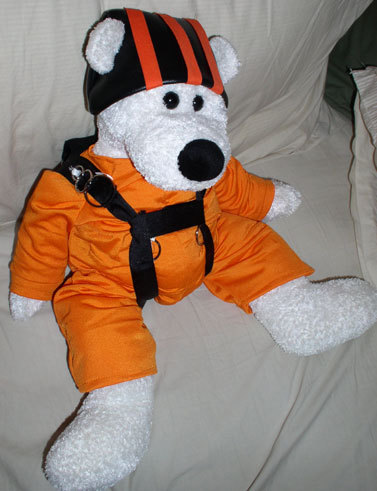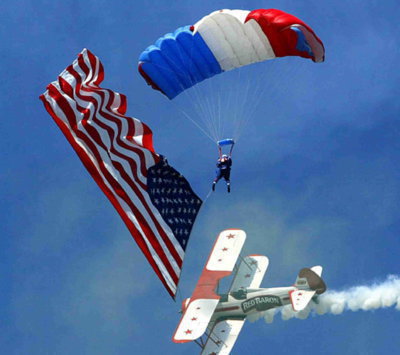Recommended Posts
wmw999 2,444
On the other hand I was taught it in 1975 in Houston, and when I became an instructor a few years later I taught it until we got piggybacks.QuoteDid my first jump in 1980, and covering the cape wells wasn't taught....at least not by the LA Tech college boys.
Obviously you guys should have come to Houston [;P]
Wendy W.
mccurley 1
Ah the good old days
http://www.youtube.com/watch?v=eRWkEky8GoI
krkeenan 0
QuoteOn the other hand I was taught it in 1975 in Houston, .
Yeah, I was trained at Doc Anagnostos' place in Dickinson in '71, a few years before the first Spaceland. Back in the days of the Bottrell Brothers and Dave Boatman. $40 first jump class - pretty good deal.
Kevin K.
Seasons don't fear the Reaper,
nor do the Wind, the Sun, or the Rain...
Quote$40 first jump class - pretty good deal.
Pretty good deal today. In 1971 $40.00 was a lot of money.
JerryBaumchen 1,362
It wasn't the money, it was the jump that changed my life forever.
Jerry
QuoteQuote$40 first jump class - pretty good deal.
Pretty good deal today. In 1971 $40.00 was a lot of money.
***
1976 for me....75.00 F J C~~ 25.00 per static line jump.
A WHOLE LOTTA money for an 18 year old kid in school!
Best money I ever spent!
~ If you choke a Smurf, what color does it turn? ~
mccurley 1
(I had a three way $20.00 bet with mt father and uncle who were on the course with me as to who would pass training and jump first. So my first jump actually cost me $5.00 and them $65.00)
http://www.youtube.com/watch?v=eRWkEky8GoI
krkeenan 0
QuoteDidn't teach cutaways but for that price, I wouldn't teach them either.
Yeah, my FJC used the "reserve with no pilotchute - throw it in the direction of the spin" method. Sure glad I never got to try out that one !!
Kevin K.
Seasons don't fear the Reaper,
nor do the Wind, the Sun, or the Rain...
Usetawuz 1
_________________________________________
The older I get, the better I was!
wmw999 2,444
Wendy W.
steve1 5
Our student gear was a B-12 container and a military belly reserve. The static line was tied onto the cones with break cord. I remember helping pack some of these rigs when I only had about 30 jumps. We all wanted to help, and I'm not sure if there was such a thing as an instructor rating back then. Maybe there was, but a lot of rules were bent. We'd take the string from gutted out 550 cord and use this for break cord.
We were taught not to cut away...just pull your reserve with a total and throw it out in the direction of spin with a partial.
We were taught cut-aways a little later, when most of us went to para-commanders. Lot's of people still jumped rags (mostly 7-TU 28 foot rounds). Para-commanders were the canopy of choice though. Para-planes were just coming out. I remember paying about $300. for a new Red Devil P.C. I had to drop out of school to save up enough cash for a new rig. Bought a new Super Pro container and harness. This was really hot gear for that time period.
I remember being a PLF instructor when I only had about 50 jumps. Can you imagine an instructor with only 50 jumps now days? The most senior member of our club had about 500 jumps, with most people having a whole lot less. Those were the days! "Really Scary!" when you get to thinking about it....Steve1
QuoteWe all wanted to help, and I'm not sure if there was such a thing as an instructor rating back then.
Tommy Owens told me a story about when he was first learning to jump at Piru and Arvin. He said he had around 7 or 8 jumps. He would go to 7,500 jump out and it was sky, earth, sky, earth, pull. Out of frustration he went to his first jump instructor, Bill Stage. He told Bill, I jump, its sky, earth, sky, earth, pull. Tell me Bill what am I doing wrong. Bill looked at him and with a straight face said, I don't know but as soon as I figure it out I will let you know.
Bill Stage had 11 or 12 jumps at the time.
Don't need no stinking instructor.
Amazon 7
QuoteI remember being a PLF instructor when I only had about 50 jumps. Can you imagine an instructor with only 50 jumps now days?
You want to talk about the blind leading the blind.. most of the SERE instructors... the young ones that had not been to Jump School had zero jumps but were teaching their elements( classes) of pilots and other aircrew ( who also had no jumps) how to do PLF's. You could not get a slot to jump school at that time unless you were assigned to the Sea Survival School or some base level slots. BUT.. during instructor training you did hundreds of PLF's and we had the swing landing trainers..... hours and hours and hours in the pea gravel. To this day I can do a REALLLLY good PLF... IF I have to. I guess doing a few thousand of them gives you some muscle memory.
Depending on how motivated your students were.... the hop off the 12 ft high swing lander could be an interesting crash and burn for the student if you let the rope go while he was up fairly high
steve1 5
I don't know how many broken bones some of our ist jump training classes had, but there were a bunch. In every class there was usually a broken bone or two. If only more time was spent doing PLF's or possibly using a swing land trainer, this could have prevented.
Most first jump classes spent about 20 minutes on PLF's and that was supposed to be enough. No wonder their were so many injuries. In the army you spend two weeks doing these before that first jump from an aircraft while in "fright".
I felt really good on that one and only training class, when I was an instructor. I may have had only 50 sport jumps, but I could teach a really good PLF and there wasn't a single injury in that class. I just passed on what I learned in the Army Jump School.
To survive landings on windy days (back then), there were a few things you needed. Number one was being physically fit and young. A good motorcycle helmet saved my noggin a lot of times. A pair of French Jump boots were an asset. A good spot helped a lot. If all else failed a good PLF would usually save your bacon....Steve1
Amazon 7
QuoteTo survive landings on windy days (back then), there were a few things you needed. Number one was being physically fit and young. A good motorcycle helmet saved my noggin a lot of times. A pair of French Jump boots were an asset. A good spot helped a lot. If all else failed a good PLF would usually save your bacon..
Ah yes.. Feet....... Butt.......Head..... Motorcycle helmet GOOOOOOOOD.
I always taught to turn a bit OFF the wind line under rounds.. it helped to get you into a better position if you were about 30 degrees off the wind line.. made for a better PLF when you were backing up..Directly into the wind made it a lot harder to get all the points of contact on the calf and thigh and hip and across the back muscles for a good roll. I do not know HOW many people I have watched that had their legs out in front of them( and they still do it) so that they were guaranteed to hit feet-butt-head.... and that would really ring their chimes for them.
steve1 5
.
Yep, I know exactly what you're talking about....Steve1






A girl at the DZ, with maybe a hundred jumps or so, was jumping her first rig, a well used one with a round reserve.
It wasn't quite the old days, more like 1991, so there still were plenty of used rigs with round reserves around.
The actual reserve system, however, was from the old days -- a diaper-less round with the lines stowed in the pack tray.
One day she mal'd, chopped, and went to the reserve. BAM!, a hard opening and a big holes in the canopy that weren't vents. One line broke and two panels were torn between reinforcing bands. She wasn't a big person and took the hard landing without real injury.
What had happened? In the pack tray was one grommet with a flange bent up 90 degrees. Those old rigs weren't heavily reinforced around the 2-pin reserve closing loop, so the flexing tray allowed the edge of a grommet to stick up a bit, in the path of all those lines stowed in the pack tray on a no-diaper reserve. One line had snagged the grommet, resulting in the out of sequence deployment and luckily 'only' a broken line and a couple panels.
Another time the same girl blew open the center top skin of her main from nose to tail. I was looking down at her after her opening and wondered for a moment what the wavy fabric was, but just went back to flying my own canopy. The canopy stayed inflated. (This was an F-111 7-cell, with maybe 150 lbs total on a 220 or so canopy.) After landing, she complained about the hard landing and crummy flare, and went to pack. She's yanking on the packing tabs one by one while flat packing, 1...2...3...and then #4 pulls way out from the rest of the canopy, attached to torn fabric. Only then did she realize she had had a mal.
So in her few years in the sport before retiring to start a family, Sylvie had managed to blow up both a main and a reserve canopy.
(While I do like the real old days stuff from the 60's and 70's in this thread, I hope there's some tolerance for newer stuff here, without getting finicky with dates! There is a "Scary Stories from Today" thread, but I haven't seen anything in between.)
Share this post
Link to post
Share on other sites